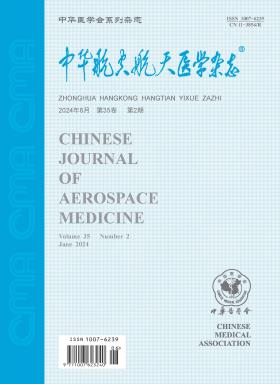Effects of Rosuvastatin Calcium on insulin resistance of the flying personnel with metabolic syndrome
引用次数: 0
Abstract
Objective To investigate the effects of Rosuvastatin Calcium on insulin resistance (IR) in the flying personnel with metabolic syndrome (MS). Methods Sixty-five cases of flying personnel with metabolic syndrome were assigned to group A (32 cases) and group B (33 cases) according to double blind and control method. Group A was administered with Rosuvastatin Calcium (10 mg/d) while group B was ingested by placebo (10 mg/d) with dinner. Homeostasis model assessment insulin resistance index (HOMA-IR) and drug adverse reactions of 2 groups were observed and compared before and 4 weeks after the treatment. Results There was no significant difference in the level of HOMA-IR, fasting insulin (FINS) and fasting blood glucose (FBG) between group A and group B before treatment (P>0.05). After 4-week treatment, HOMA-IR, FINS and FBG of group A was significantly lower than that of group B (t=2.895-3.231, P 0.05). There was significant difference of HOMA-IR, FBG in each group after treatment (t=4.228-8.846, P 0.05). FINS and FBG were positively correlated with HOMA-IR (r=0.436-0.982, P 0.05). Flying personnel of group A and group B were well tolerated to the treatments of Rosuvastatin Calcium. Glutamic-pyruvic transaminase, creatinine and creatine kinase had no significant difference by the treatment (P>0.05). Conclusions Rosuvastatin Calcium could improve IR in the flying personnel with MS. It is suggested that healthy lifestyle should be build and Rosuvastatin Calcium would be taken for the flying personnel with MS to effectively improve their IR if necessary. Key words: Insulin; Metabolic syndrome X; Rosuvastatin calcium; Flying personnel瑞舒伐他汀钙对飞行人员代谢综合征胰岛素抵抗的影响
目的探讨瑞舒伐他汀钙对飞行人员代谢综合征(MS)胰岛素抵抗(IR)的影响。方法采用双盲对照法将65例飞行人员代谢综合征患者分为A组(32例)和B组(33例)。A组给予瑞舒伐他汀钙(10 mg/d), B组给予安慰剂(10 mg/d),随餐服用。观察并比较两组患者治疗前和治疗后4周胰岛素抵抗指数(HOMA-IR)及药物不良反应。结果A组与B组治疗前HOMA-IR、空腹胰岛素(FINS)、空腹血糖(FBG)水平比较,差异均无统计学意义(P < 0.05)。治疗4周后,A组HOMA-IR、FINS、FBG均显著低于B组(t=2.895 ~ 3.231, P 0.05)。治疗后各组HOMA-IR、FBG比较,差异均有统计学意义(t=4.228 ~ 8.846, P 0.05)。FINS、FBG与HOMA-IR呈正相关(r=0.436 ~ 0.982, P 0.05)。A组和B组飞行人员对瑞舒伐他汀钙治疗耐受良好。谷丙转氨酶、肌酐、肌酸激酶各处理间差异无统计学意义(P < 0.05)。结论服用瑞舒伐他汀钙可改善MS飞行人员IR,建议建立健康的生活方式,必要时服用瑞舒伐他汀钙可有效改善MS飞行人员IR。关键词:胰岛素;代谢综合征X;伐钙;飞行人员
本文章由计算机程序翻译,如有差异,请以英文原文为准。
求助全文
约1分钟内获得全文
求助全文
来源期刊

中华航空航天医学杂志
航空航天医学
自引率
0.00%
发文量
2962
期刊介绍:
The aim of Chinese Journal of Aerospace Medicine is to combine theory and practice, improve and popularize, actively advocate a hundred flowers bloom and a hundred schools of thought contend, advocate seeking truth from facts, promote the development of the related disciplines of aerospace medicine and human efficiency, and promote the exchange and penetration of aerospace medicine and human efficiency with other biomedical and engineering specialties.
Topics of interest for Chinese Journal of Aerospace Medicine include:
-The content of the journal belongs to the discipline of special medicine and military medicine, with the characteristics of multidisciplinary synthesis and cross-penetration, and mainly reflected in the aerospace industry, aerospace flight safety and efficiency, as well as the synthesis of special medicine, preventive medicine, environmental medicine, psychology, etc.
-Military aeromedicine (Air Force, Navy and Army aeromedicine) and civil aeromedicine, with a balance of aerospace medicine are the strengths of the journal.
-The change in aerospace medicine from a focus on promoting physiological compensatory adaptations to enhancing human performance under extreme environmental conditions is what the journal is helping to promote.
-The expansion of manuscripts in high altitude medicine is also a special emphasis of the journal.
 求助内容:
求助内容: 应助结果提醒方式:
应助结果提醒方式:


